|
|
|
Sort Order |
|
|
|
Items / Page
|
|
|
|
|
|
|
| Srl | Item |
| 1 |
ID:
093202
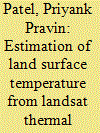

|
|
|
| 2 |
ID:
130749
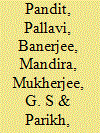

|
|
|
|
|
| Publication |
2014.
|
| Summary/Abstract |
Poly (L lactic acid) (PLLA) ultrathin films of various thicknesses were prepared by spin coating method and investigated by using vibrational spectroscopic techniques such as FTIR and Raman. The analysis has been done in two parts: first one is verification of structural mode to understand the visibility of characteristic band to confirm the PLLA structure; where interestingly, as the thickness of the film increased, the structural features were found to be more explicit. The second part of the study was to observe the features of the film having been annealed for 1 h in two separate temperatures, one at specific annealing temperature 120 °C and the other at 160 °C to enable PLLA chains to reorient to get crystallized from its soften state at two such specific temperatures. The isothermal crystallization behavior of PLLA film at 120 °C and 160 °C from the melt was monitored by FTIR as well as Raman spectroscopies. More importantly, the band at 921 cm-1 corresponds to ? crystalline phase of PLLA has been observed even in this ultrathin film with the effective application of temperature as selected in this study.
|
|
|
|
|
|
|
|
|
|
|
|
|
|
|
|
| 3 |
ID:
182776
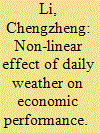

|
|
|
|
|
| Summary/Abstract |
This paper thoroughly examines the impacts of daily weather on the aggregate economic outcomes in China and identifies the underlying channels. Using within-county variations in daily weather between 1996 and 2012, we find that daily temperature and precipitation have non-linear effects on county-level economic outcomes. An additional day with an average temperature above 20 °C reduces county-level GDP by 0.05% to 0.08%, and the detrimental effects tend to intensify when the temperature rises. The precipitation does not have robust effects on county-level GDP. By examining the effects of daily weather on primary, secondary, and tertiary industries, we find that the primary industry is the main channel of the negative impacts of high temperatures. Heavy precipitation is inclined to harm agricultural output, especially grains and oil crop yields. Besides, we discover heterogeneous responses to weather extremes across counties and find suggestive evidence of adaptation.
|
|
|
|
|
|
|
|
|
|
|
|
|
|
|
|
| 4 |
ID:
117549
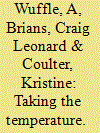

|
|
|
| 5 |
ID:
134153
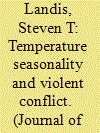

|
|
|
|
|
| Publication |
2014.
|
| Summary/Abstract |
Current climate change research suggests that certain seasonal weather patterns will be extended and others attenuated as global temperature increases. This is important because seasonal temperature change affects both the scarcity of resources during certain times of the year and the overall mobility of people living in countries that have seasonality. Consequently, these seasonal changes have implications for the onset of violent conflict, particularly as it relates to distinguishing when, where, and how it is most likely to occur. This article evaluates the relationship between monthly temperature changes, civil war onset, and various, less-organized conflict events, offering theoretical expectations for how seasonal changes and climate aberrations are related to an increased risk of violence. The results show that prolonged periods of stable, warm weather are consistently associated with an increased risk of civil war onset and non-state conflict. These findings are best explained through the strategic viability mechanism of temperature change, which allows actors to resolve their collective action problems that are often associated with poor weather conditions, while simultaneously increasing their strategic and behavioral incentives for engaging in violent conflict. Warm weather generates more resources for rebel looting and permits predictability for coordinating troop movements and strategy development. These findings are particularly salient in areas of the world affected by strong seasonality, where prolonged extensions of warm weather conditions would be regarded as both peculiar and attractive for participating in violent action. Although these findings are notable, even under the most extreme climate change scenarios, the substantive effects for these relationships are comparatively minor relative to other well-known intrastate Conflict Covariates.
|
|
|
|
|
|
|
|
|
|
|
|
|
|
|
|
|
|
|
|
|